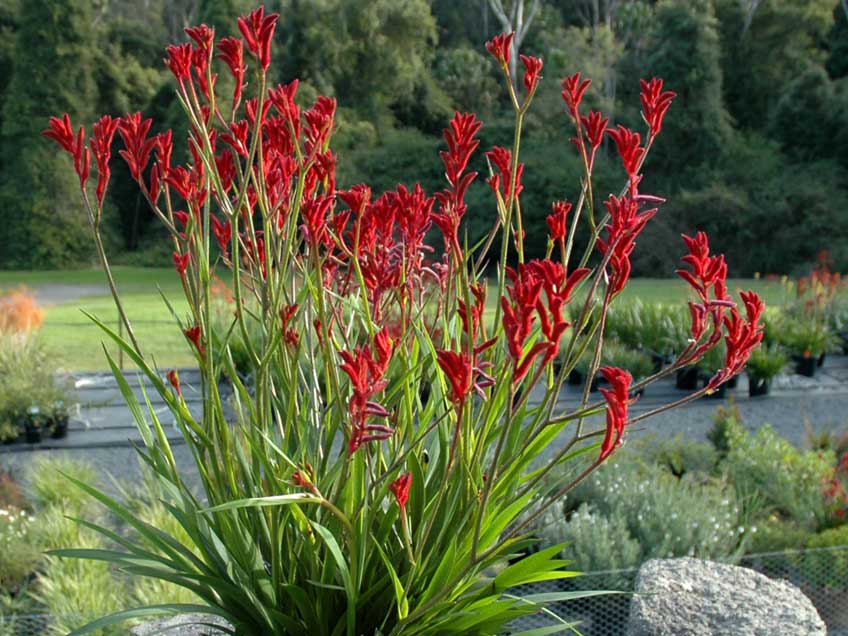These furry, iconic Australian flowers are a great addition to a potted garden, especially the smaller varieties.
As long as you have a space that sees full sun and they’re planted into a native potting mix, you can’t go wrong. From now until early summer keep up the water to maintain colour and extend longevity in the blooms. To stimulate new growth, cut back old flower stems and foliage to the base.

Such long flowering keeps the balcony looking good. Photo - Ramm Botanicals
Kangaroo Paw 'Bush Gems' range (Anigozanthos hybrids)
I love Kangaroo paw (Anigozanthos sp.), they are one of my favourite natives. I grow purple, pink & lemon paws. They have two meter high flower stems
that attract honeyeaters, and green frogs find homes amongst their foliage. I only grow the tall ones as the dwarf varieties live for a short time,
usually only two years or so.
We like... Bush Gems Landscapers is a separate range of kangaroo paws that have been specifically bred for long-lived performance
in commercial and domestic garden usage. High on the list of breeding priorities were disease tolerance, adaptability to a wider range of soil types,
strong, upright foliage and flowering stems and, of course, great flower colours. Bush Gems Landscapers breeding program was started by Angus
Stewart and Ramm Botanicals in recognition of the need to improve genetics and put focus on this important category of kangaroo paws.
Flowering: Spring, summer, autumn
Aspect: Full sun, full sun/part shade, coastal, drought tolerant, light frost tolerant, heat tolerant
Size: Height to 1.6m, width to 1m
Care: Plant on slightly mounded soil that drains away excess moisture. Give them a dose of native fertiliser late winter and again
in late spring. Although more tolerant of clay soils than most paws, if drainage is poor, it’s still best to break down the clay with gypsum or build
up the bed to provide good drainage so the plant can perform at its best. Protect from heavy frost.
Pruning: April is a good time to cut the old flower stems back to ground level. They also can be divided now by digging the clump out.
Then cut through with a spade into four, removing any old or diseased leaf fans (you'll see the new leaves shooting from the clump). This will give
you 4 more plants to spread around.
Troubleshooting: They have annoying hairs that itch forearms, necks and exposed skin. Wear long gloves and avoid the falling flowers when
cutting back. Avoid overwatering and humid locations of the garden if possible. Ink spot can affect some varieties if they are under stress. Keep them
healthy and plant in a sunny, well ventilated position.
Watering
These Landscapers are very drought hardy and are designed to survive on natural rainfall once established. However, like all plants, they need water,
so during extended dry spells, it’s a good idea to give them an occasional soaking.
Feeding
Anigozanthos are not especially phosphorus sensitive, so you needn’t necessarily have to use a native plant fertiliser. Feed in autumn and spring with
controlled release fertiliser to promote good plant health and prolific flowering.
Pruning
Cut old flowering stems back to their base to tidy up the plant and encourage repeat flowering. You can cut the whole plant back to just above ground
level. New shoots will appear from underground rhizomes. Older plants will benefit from the annual removal of any damaged leaves. Use secateurs, a
chain saw, even a slasher!
Pests and Diseases
Snails and slugs are the most common pest but we often find green frogs at home in our kangaroo paw clumps. Although Bush Gems Landscapers have been
bred to resist or tolerate rust or ink spot disease, it may still be possible to see blackening of the foliage. This is more of an aesthetic problem
than something that will hurt the plant, just remove any badly affected leaves.
Text: Linda Ross